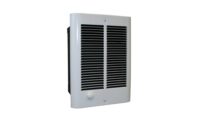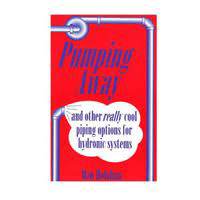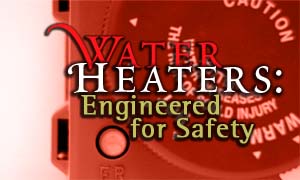
Issue: 5/04
Over the past two centuries, hot water has evolved from an occasional indulgence for the very rich to an indispensable part of our daily lives, both at home and on the job. Progress has been so swift and comprehensive that we often take for granted the technologies that make hot water-on-demand possible and affordable, as well as the measures that assure its safe and smooth delivery.
With the many advances in water heaters, safety must always be a concern-not only for manufacturers and end users, but for specifying engineers and municipalities as well. Water heater safety can be addressed in three major categories: design, installation and end usage. Each is impacted by a variety of standards, both mandated and voluntary.
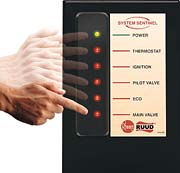
Design Safety: Commercial Gas
Commercial tank-type gas water heaters (inputs above 75,000 Btu per hour) must meet American National Standards Institute (ANSI) Z21.10.3-2001, which covers the design areas of construction, performance, manufacturing and production.Construction criteria include a wide range of items: general construction, materials, combustion air supply, burners, ignition systems, gas connections, dip tubes, temperature and pressure release valves, draft hoods, and vent dampers. Engineers must document all materials used to ensure compliance with ANSI construction standards, and this information must be available during the certification process.
Performance criteria cover many of the heater operation safety requirements. This includes all testing of the gas combustion during operation, as well as the by-products of that combustion. This section also covers the methods of controlling the water temperature inside the tank. The test performed by engineers and third party certification agencies ensures that:
- 1. Burners, orifices, gas valves, and gas pressure comply with the designed Btu/h rating; and
2. Combustion gases are within safe limits.
Other requirements address the ability of the water heater and its various components to provide ignition. If the gas valve, pilot, thermostat, hi-limit, or vent damper fail to signal that they are ready for combustion, the ignition system is designed not to ignite the main burner.
Some commercial water heater models now provide electronic diagnostics to help troubleshoot start-up or other problems by monitoring each critical component. Installers and service contractors need only scan a small bank of LED lights on the outside of the water heater to verify the sequence of operation.
In addition to the above performance criteria, the ANSI standard also addresses a number of other factors:
- Distance to combustibles: Called "alcove testing," this test allows engineers to measure exterior water heater temperature to determine how close water heaters can be installed to floors, walls and ceilings.
- Venting: Draft hoods and vent dampers are tested to prevent downdraft and spillage of flue gases.
- T&P and ECO operation: Repeated short draws on the system create a "stacking" effect (thermal stratification) inside the tank, with hot water at the top and cold water at the bottom. Tests are therefore designed to simulate small usages of hot water over a relatively short period, verifying that the T&P (temperature and pressure relief valve) and the ECO (energy cutoff) properly control the water temperature, which either relieves the tank of water that is above a predetermined maximum temperature and pressure or shuts the heater off.
- Hydrostatic testing of the storage tank: ANSI hydrostatic testing is done during certification and is therefore design-certified. ASME hydrostatic testing requires that each pressure vessel be tested, inspected and approved by an onsite National Board inspector.
- Manufacturing and production criteria address issues regarding manufacturing processes, quality assurance procedures and product testing.
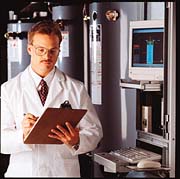
Design Safety: Commercial Electric
Commercial electric models are tested to meet UL 1453 standards for units above 12 kilowatts (kw), over 120 gallons, or whose water temperature exceeds 185
Design Safety: Residential Gas
Residential gas water heaters (75,000 Btu/h and less) are certified to ANSI Z21.10.1-2002. Like commercial gas water heaters, residential heaters are subject to similar construction and performance criteria. The main difference is a new safety standard, which went into effect July 1, 2003.ANSI Z21.10.1a-2002 addresses the problem caused by improper storage or use of gasoline or other flammable liquids near residential gas-fired water heaters. To meet the new Flammable Vapor Ignition Resistance (FVIR) Standard, a water heater must be designed so it cannot ignite flammable vapors caused by spilled gasoline outside the unit. Initially covering residential gas-fired water heaters with storage capacities of 30-, 40- or 50-gallon capacities, the new standard will eventually cover all residential gas-fired models. (Figure 1 shows the complete implementation schedule.)
Figure 1. FVIR Implementation Schedule for Gas-Fired Water Heaters
Phase Gallon Capacity Type Effective Date
I 30, 40, 50 Conventional July 1, 2003
II 30, 40, 50 Power-Vented January 1, 2005
III Remaining Product Remaining Product July 1, 2005
Key design differences: The various FVIR water heater brands share several features and components. The most important is a flame arrestor plate that prevents a flammable vapor fire inside the water heater from igniting outside the water heater. Some manufacturers will also continue to use the same gas valves, thermocouples and other conventional components that contractors already carry in their shops and on their service vehicles. As a result, any service technician working with a water heater brand that uses common components should not encounter any significant changes in his troubleshooting routines.
Despite all this continuity, there are significant differences in how each brand responds to flammable-vapor incidents, as well as to potential problems with lint, dust and oil (LDO). The critical design variations manifest themselves in three areas:
- Air intake: The path that makeup air will follow into the water heater's combustion chamber will vary from brand to brand. Some units will continue to take air in through their bottoms. Others prefer to use the sides to minimize problems with lint, dust and oil, all of which tend to collect on the floor.
- LDO: Lint, dust and oil are air contaminants that could clog the arrestor over time, interrupting the smooth flow of makeup air into the combustion chamber and undermining performance. Under these conditions, the burner would be starved for oxygen and might release unacceptable levels of carbon monoxide into the atmosphere. To combat the effects of LDO, some new FVIR water heaters have incorporated integrated filter designs. Others have replaceable filters or screens. Still others need no filter at all. These differing strategies inevitably impact maintenance routines. Certain models require periodic cleaning or replacement of these screens or filters.
- Water heater shutdown: As noted above, the flame arrestor plate will prevent flames from escaping the combustion chamber into the outside room. However, the new standard does not address the problem of a sustained flammable vapor event, in which the vapors continue to burn inside the combustion chamber. Shutting off the gas, as required by the standard, will not halt this internal combustion. That's why some FVIR systems are designed to choke off any fire in the chamber by completely shutting down not just the gas, but also the air, thus delivering double-protection.
A decade ago, engineers and contractors learned that not all low-flush water closets are the same. That the same lesson applies equally well to FVIR water heaters. Whatever brand they specify today, engineers should take the time to investigate the design and performance differences among the various makes and models. Only by fully understanding all these differences can they decide which brand will provide the best long-term solution for a project.

- the Heavy Duty Electric (left), with an ASME steel tank that is hydrostatically tested up to 300 pounds per square inch, in accordance with the ASME Boiler and Pressure Vessel Code; and
- the Universal Commercial Gas Water Heater (right), whose smaller jacket diameters and low-profile automatic flue damper (top) make it easier to maneuver into tight commercial spaces.
Design Safety: Residential Electric
Residential electric water heaters (below 12 kw) are subject to the UL 174 standard. Like the standard for their commercial counterparts, this one ensures that the wire gauge, amperage rating and grounding are safe. Also, all electrical components must meet other UL standards and be rated for use in a water-heating appliance. Tanks are also hydrostatically tested and design-certified to meet the standards requirements.
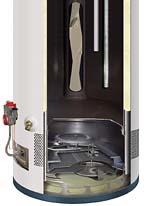
Installation Safety
The water heater manufacturer provides only one component of a complete water heating system: the water heater itself. Certification of that product begins at the gas valve inlet and necessarily ends at the top of the draft hood or vent damper. But the safe installation, operation and maintenance of that certified product require an in-depth knowledge of several resources. These include-but are not limited to-the manufacturer's Use & Care Manual, the National Fuel Gas Code or National Electric Code, state and local plumbing and/or gas/electrical codes.
Some of the issues addressed by codes are gas piping, water piping, venting, seismic protection and installation constraints. Water heaters are manufactured to meet national requirements but sometimes offer models designed to meet state code requirements; e.g., Low-NOx models for Southern California and Texas. When specifying a water heater, engineers must be mindful of any local code requirements to specify the correct product for a particular area. If in doubt, one of the best sources of information is the local code inspector's office.

User Safety
End-user safety involves several areas:
- Use and care directions: These should be followed with regard to all post-installation activities.
- Water temperature: Tempering or mixing valves should be considered if storage temperatures exceed 120
